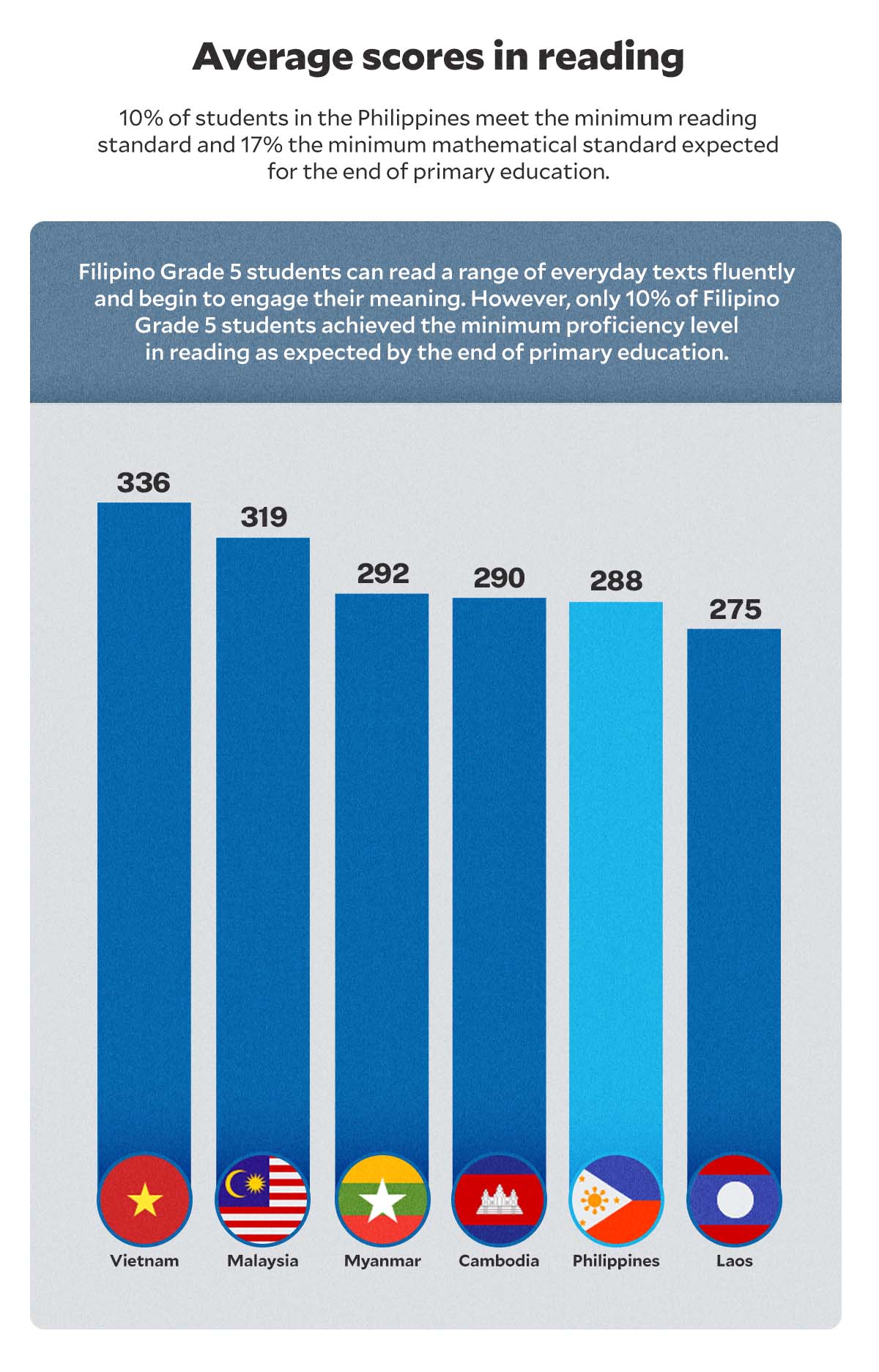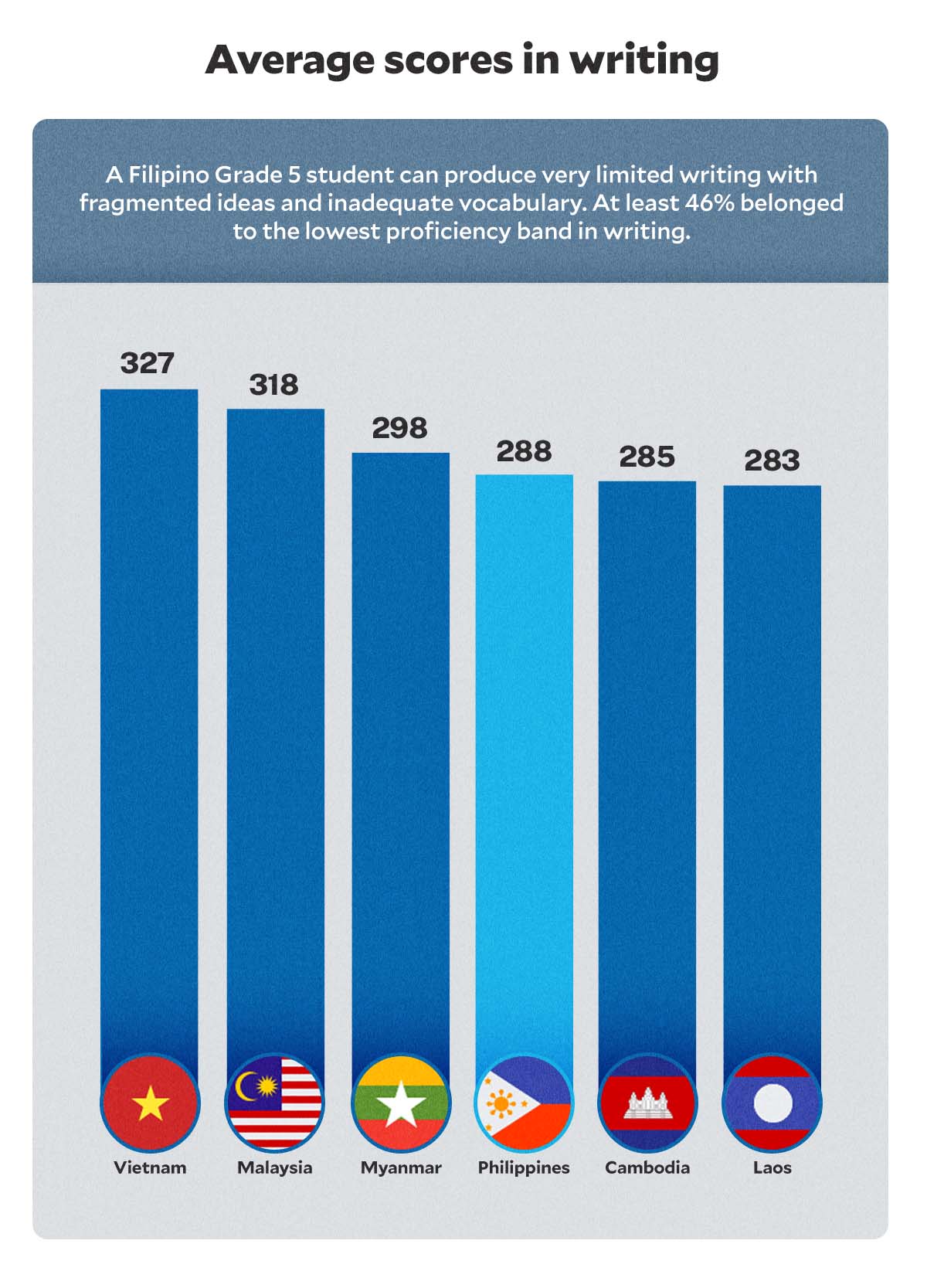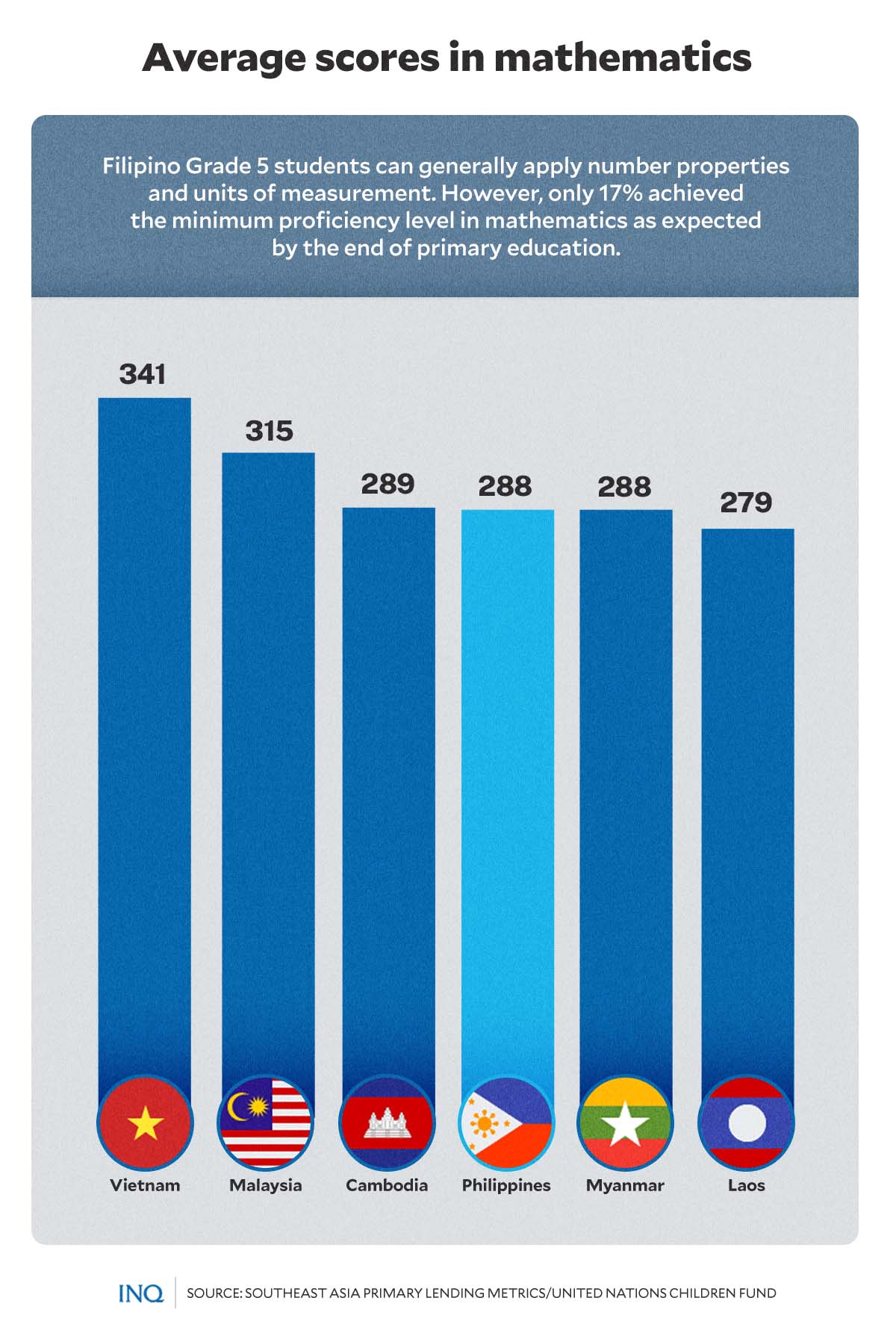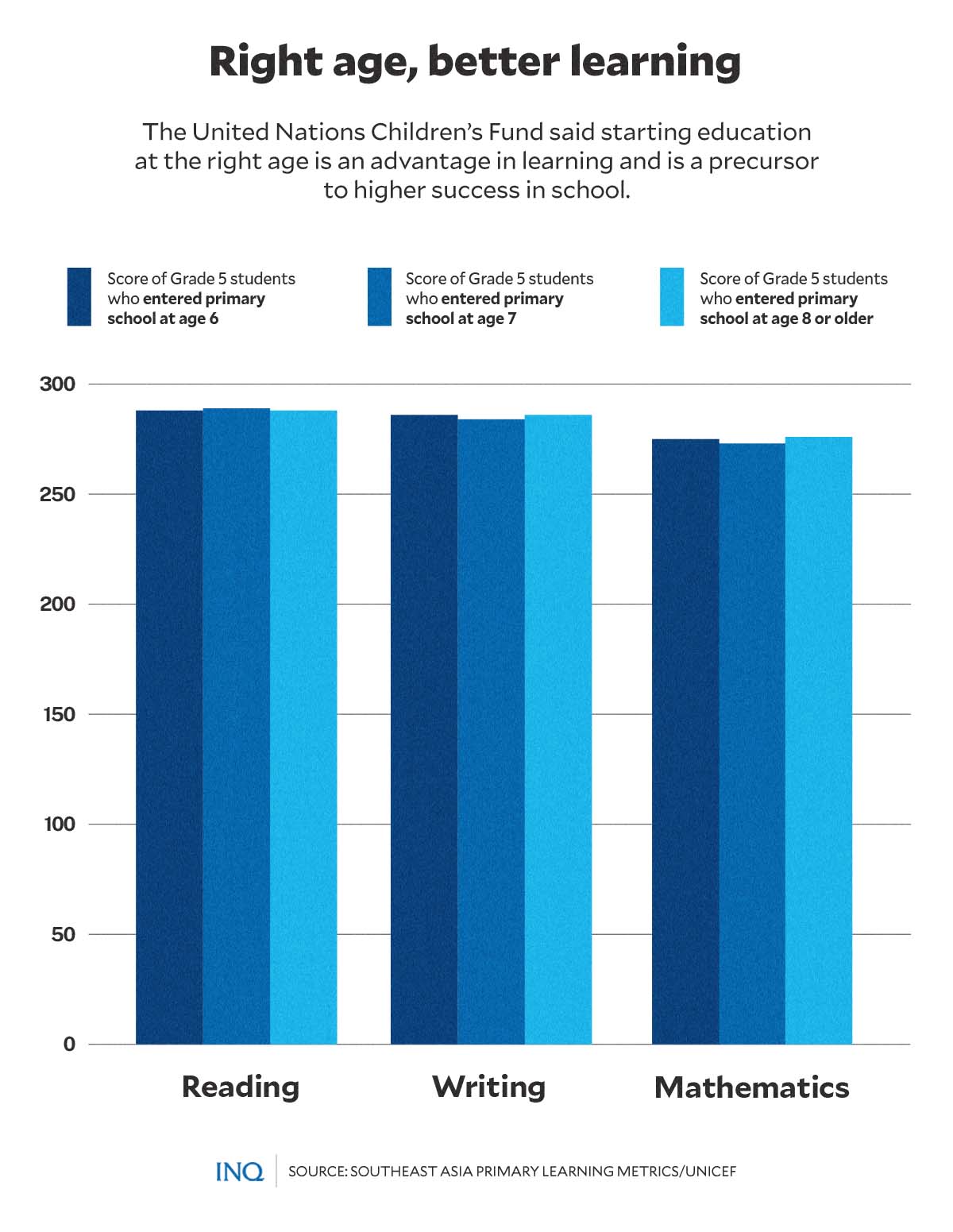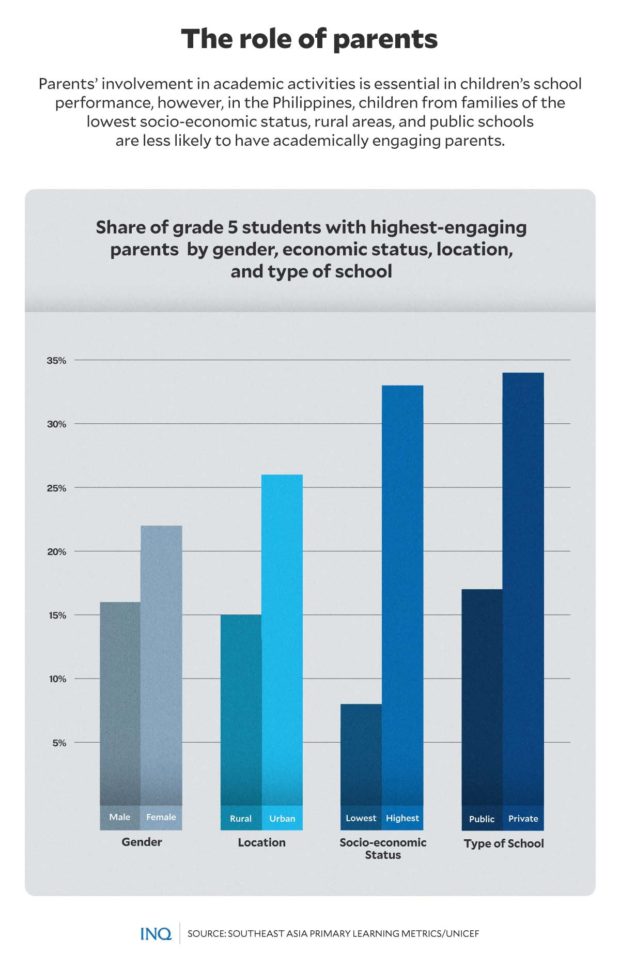Southeast Asia rank: PH 2nd to worst in Grade 5 students’ reading, math skills
MANILA, Philippines—As most Grade 5 students in the Philippines and its poorer neighbors do not have the minimum reading and mathematical skills expected at the end of primary education, the United Nations Children’s Fund (Unicef) stressed the need to “harness the potential” of early childhood education (ECE).
Through the Sustainable Development Goals (SDGs), the UN in 2016 called for access to quality basic education for all children, including some 30 million learners in the Philippines, to lead students to relevant learning outcomes and equip them with required skills, especially in language and mathematics.
But based on results of the Southeast Asia Primary Learning Metrics 2019 (SEA-PLM), only 10 percent of students in the Philippines met the minimum reading standard and 17 percent met the minimum mathematical standard expected at the end of primary education, as provided in SDG 4.1.1—Education Proficiency.
Grade 5 students in the Philippines received an average score of 288 in reading assessment, behind Vietnam (336), Malaysia (319), Myanmar (292) and Cambodia (290). The Philippines was ahead only of Laos, where students got an average score of 275.
While the 288 means a Filipino Grade 5 student can read a range of everyday texts fluently and comprehend their meaning, only 10 percent achieved the minimum proficiency level, which is the ability to understand texts with familiar structures and manage competing information.
Article continues after this advertisementRELATED STORY: WB: PH ‘learning poverty’ among highest in region
Article continues after this advertisementThe average score of Filipino Grade 5 students in mathematics assessment was also 288, indicating that they can generally apply number properties and units of measurement, but only 17 percent had the ability to perform mathematical operations, including fractions, and interpret tables and graphs.
The Philippines and Myanmar, where students also got an average score of 288, were behind Vietnam (341), Malaysia (315) and Cambodia (289), and were ahead of Laos, where Grade 5 students received an average score of 279.
When it comes to writing assessment, Filipino Grade 5 students also received an average score of 288, behind Vietnam (327), Malaysia (318) and Myanmar (298), and ahead of Cambodia and Laos, where students got an average score of 285 and 283.
This suggested that a student in the Philippines can produce very limited writing with fragmented ideas and inadequate vocabulary as some 46 percent fell to the lowest proficiency band in writing—those who have limited ability to present ideas in writing and can produce a few sentences with very limited content.
What’s wrong?
Unicef stated in its latest policy brief that the Philippines supports one year of kindergarten education for all five-year-old children as mandated by the Kindergarten Education Act of 2012, which provides for the institutionalization of kindergarten education as part of basic education in the Philippine Educational System.
Likewise, the Early Years Act of 2013 mandated the Early Childhood Care and Development (ECCD) Council to coordinate ECCD programs offered by government agencies, including the provision of pre-school education for children who are three to five years old.
Early childhood education (ECE), it said, “offers a vital foundation for lifelong learning by nurturing children’s foundational and transferable skills that prepare them to participate in primary education and beyond.”
ECE likewise lessens the risk of school failure.
Based on the SEA-PLM National Report of the Philippines, Grade 5 students who attended an ECE program before entering primary school perform better in reading, writing, and math assessments, compared to those who have no ECE experience.
Almost 95 percent of children who had two years of ECE were able to read words even before primary education, compared to only 88 percent who did not have ECE experience.
At least 92 percent of those with two years of ECE were able to do simple addition, compared to only 87 percent who did not attend ECE programs.
But despite the benefits of ECE experience and the government policies that support it, the program is still “limited” in the Philippines as only 66 percent of five-year-old children were enrolled in kindergarten, while only 47 percent of children three to four years old were in preschool.
“It is imperative to ensure all Filipino children have access to quality ECE,” Unicef said.
Disparity in access
Factors such as gender, socio-economic status (SES), location, and school type set apart students’ ECE participation. While location and gender disparities in ECE attendance are relatively small, there are more marked gaps by SES and school type.
While 93 percent of students from the highest-SES families attended at least a one-year ECE program, the figure is 83 percent for students from the lowest-SES households.
Likewise, 54 percent of children from the highest-SES families participated in an ECE program for two years or more, compared to 39 percent from the lowest-SES students.
“This is consistent with global evidence that access to ECE has a strong association with household factors,” Unicef said.
When it comes to school types, 95 percent of students from private schools participated in at least a one-year ECE program, compared to 84 percent of students from public schools. More than 62 percent of students from private schools received two years or more of ECE, compared to 41 percent of students from public schools.
“The disparity in ECE attendance by urban-rural divisions is not so apparent,” Unicef said.
Eighty-six percent of students from urban areas received ECE for one year or more, compared to 85 percent among those from rural areas. However, children from urban areas have a slightly greater advantage in attending ECE programs for more than two years. Half of students who live in urban areas participated in a two year ECE program.
There is also a small gender disparity in ECE participation, although girls have a slightly greater advantage than boys. Specifically, 88 percent of girls received at least a one-year ECE program, compared to 83 percent of boys. Almost an equal share of girls (44 percent) and boys (43 percent) attend an ECE program for two years or more.
Give ECE access to all
According to Unicef, it is “critical to increase participation in kindergarten so that all children are physically, socio-emotionally, and intellectually prepared for primary education.”
To achieve this, while the analysis shows that children from low-SES families and public schools are at a relative disadvantage in accessing ECE, data collection needed to be strengthened in the school level to identify the profile of children who are not attending kindergarten and the barriers they are facing in accessing the services.
“At the same time, as the disparity in ECE attendance by SES is prominent, household factors may play a strong role in children’s access to ECE. In this sense, parents from low-SES families should be capacitated in their responsibilities to send their children to ECE,” it said.
Then in areas where it is difficult to reach public schools, partnerships with non-government service providers may play a crucial role in ensuring access to kindergarten.
Likewise, Unicef stressed that alternative kindergarten models and catch-up programs may supplement access in this regard.
‘Right age’ to go to school
Unicef said starting education at the right age will also give a head start in learning and could help achieve higher success in school, with data suggesting that children who received ECE are more likely to attend primary education at age 6, which is the official primary school starting age in the Philippines, compared to those who did not attend ECE.
It stressed that students who entered primary education at a later age perform significantly worse in reading, writing, and mathematics than peers who joined at the right age.
Based on results of the SEA-PLM, which is a large-scale regional learning assessment program to assess learning outcomes of Grade 5 students in Southeast Asia, students who entered primary school at age 6 received a 288 score in reading assessment, compared to those at age 7 (286) and 8 or older (275).
Then in writing assessment, Grade 5 students who entered primary school at age 6 got a score of 289, higher than those who entered primary school at age 7 (284) and 8 or older (273).
Likewise, students who entered primary school at age 6 received a score of 288 in math assessment, compared to those who entered primary school at age 7 (286) and 8 or older (276).
Academically engaging parents needed
It was revealed that Grade 5 students whose parents were more involved in their academic activities had higher scores in reading, writing, and mathematics.
But among the six SEA-PLM participating countries, Filipino children had the largest gap in test scores between those with the highest-engaging parents and the lowest ones, implying that parents’ involvement in academic activities is essential in children’s school performance.
Unicef said although gender disparity remains relatively small, girls are slightly more likely to have the most academically engaging parents than boys. Specifically, 22 percent of girls are supported by the highest-engaging parents on learning, compared to 16 percent of boys.
When it comes to geographic location, parental engagement in academic activities is more prominent in bigger municipalities and cities, with 26 percent of children from urban areas having the highest-engaging parents, compared to 15 percent of children from rural areas.
“There is also a marked disparity by school type at the expense of children from public schools. Thirty-four percent of children in private schools are supported by highly engaging parents, while the figure is only 17 percent for children in public schools,” Unicef said.
However, disparity by SES appears more significant than disparity by gender, location, and school type as 33 percent of children from the highest-SES families have the most academically engaging parents, compared to 8 percent of those from the lowest-SES households.
‘Upgrade teachers’ knowledge, skills’
Based on results of the SEA-PLM, instructional training enables teachers to acquire sufficient knowledge and skills to deliver quality education, and is essential to promoting student achievement.
However, data suggest that most teachers in Grade 5 did not receive pre-service training in teaching foundational skills in the classroom.
This, as among teachers with less than two years of teaching experience, only 7 percent had training in math before they entered the classroom, followed by 8 percent in reading, and 13 percent in writing.
“The figures essentially remain unchanged even among teachers with longer teaching experience” as only about 5 percent to 6 percent of those with more than two decades of teaching experience had received pre-service training in reading, writing, and mathematics.
In-service training opportunities are also still limited for early career teachers, with only about 6 percent of teachers with less than two years of experience having in-service training in writing, 14 percent in mathematics and 17 percent in reading.
But Unicef said teachers are likely to receive in-service training in foundational skills throughout their teaching career.
RELATED STORY: Face-to-face classes back, but can these reduce 91% learning poverty in PH?












